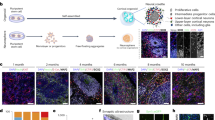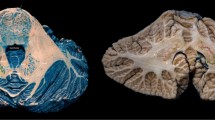Summary
Based on three experiments, this study examined whether behavioral and histological effects of fetal septal or hippocampal grafts placed in the denervated hippocampus depend on the duration of post-grafting delays. Each experiment included four groups of rats: sham-operated rats (Sham), rats with aspirative lesions of the fimbria-fornix (Fifo) and rats given both Fifo lesions and intrahippocampal fetal suspension grafts of either septal (Fifo.ST) or hippocampal (Fifo.HT) origin. All rats were tested (i) for home cage activity, (ii) for activity and reactivity in an open field and (iii) for learning ability in a 8-arm radial maze. Except for home cage activity which was also monitored preoperatively, behavioral tests were conducted between 1–2 months postgrafting in Experiment 1 (EXP1), 5–6 months post-grafting in Experiment 2 (EXP2) and 10–11 months postgrafting in Experiment 3 (EXP3). Each test period lasted 3 weeks. Histological controls consisted of acetylcholinesterase (AChE) and cresyl violet staining. Graft size was estimated by computerized image analysis. Normal rats performed well in each experiment. In all experiments, rats with fimbria-fornix lesions showed increased activity in both their familiar (home cage) and unfamiliar (open field) environments, and their performances in the radial maze task were impaired. In no experiment did grafts, whether hippocampal or septal, affect “noncognitive” behavioral variables. However, maze performance was improved by hippocampal grafts in EXP1 (short delay) and by septal grafts in EXP2 (intermediate delay). No graft-induced effect was found in EXP3 (long delay). Concerning AChE-positivity in the dorsal hippocampus, fimbria-fornix lesions reduced staining densities by at least 60%. Both types of grafts were undiscernably AChE-positive, but only septal grafts provided the denervated hippocampus with a significant AChE-positive fiber ingrowth. Differences among groups in density of hippocampal AChE staining were comparable in all three experiments and no correlation between hippocampal AChE-positivity and maze performance was found. Our results suggest that graft-induced recovery from behavioral effects of fimbria-fornix lesions may depend on both the type of tissue implanted (hippocampal vs septal) and the post-grafting delay (1–2, 5–6 and 10–11 months). The recovery observed at a short post-grafting delay with hippocampal grafts and at a longer post-grafting delay with septal grafts was not persistent and concerned only cognitive function as assessed by radial maze performance. Regarding (i) the absence of any correlation between AChE staining and radial maze performance, and (ii) the lack of graft-derived AChE-positive fiber ingrowth in Fifo.HT rats with improved radial maze performance in EXP1, our results also suggest that factors other than graft-derived cholinergic fiber ingrowth might be involved in the graft-induced recovery observed in the radial maze.
Similar content being viewed by others
References
Azmitia EF, Björklund A (1987) Cell and tissue transplantation into the adult brain. Ann NY Acad Sci
Bartus RT, Dean RL, Beer B, Lippa AS (1982) The cholinergic hypothesis of geriatric memory dysfunction. Science 217:408–416
Björklund A, Gage FH, Stenevi U, Dunnett SB (1983a) Survival and growth of intrahippocampal implants of septal cell suspensions. Acta Physiol Scand Suppl 522:49–58
Björklund A, Gage FH, Schmidt RH, Stenevi U, Dunnett SB (1983b) Recovery of choline acetyltransferase activity and acetylcholine synthesis in the denervated hippocampus reinnervated by septal suspension implants. Acta Physiol Scand Suppl 522:59–66
Björklund A, Stenevi U (1985) Neural grafting in the mammalian CNS. Elsevier, Amsterdam
Brundin P, Isacson O, Gage FH, Stenevi U, Björklund A (1985) Intracerebral grafts of neuronal cell suspensions. In: Björklund A, Stenevi U (eds) Neural grafting in the mammalian CNS. Elsevier, Amsterdam, pp 51–59
Butcher LL (1984) Acetylcholinesterase histochemistry. In: Björklund A, Hökfelt T (eds) Methods in chemical neuroanatomy. Elsevier, Amsterdam, pp 1–49
Buzsaki G, Czopf J, Kondakor I, Björklund A, Gage FH (1987) Cellular activity of intracerebrally transplanted fetal hippocampus during behavior. Neuroscience 22:871–884
Buzsaki G, Gage FH (1988) Neural grafts: possible mechanisms of action. In: Petit TL (eds) Neural plasticity: a lifespan approach. Allan R Liss Inc, New York
Cassel JC, Kelche C (1989) Scopolamine treatment and fimbriafornix lesions: mimetic effects on radial maze performance? Physiol Behav 46:347–353
Cassel JC, Kelche C, Dalrymple-Alford JC, Will BE (1988) Effects of physostigmine and d-amphetamine on the behavior of rats with selective fimbria-fornix lesions and intrahippocampal fetal septal cell transplants. Behav Neur Biol 50:229–239
Cassel JC, Kelche C, Will BE (1987) Susceptibility to pentylenetetrazol-induced and audiogenic seizures in rats with selective fimbria-fornix lesions and intrahippocampal septal grafts. Exp Neurol 97:564–576
Clarke DJ, Gage FH, Björklund A (1985) Formation of cholinergic synapses by intra-hippocampal septal grafts as revealed by choline acetyl-transferase immunocytochemistry. Brain Res 369:151–162
Cotman CW, Nieto-Sampedro M, Gibbs RB (1984) Enhancing the self-repairing potential of the CNS after injury. Cent Nerv Syst Trauma 1:3–14
Dalrymple-Alford JC, Kelche C, Cassel JC, Toniolo G, Pallage V, Will BE (1988) Behavioral deficits after intrahippocampal fetal septal grafts in rats with selective fimbria-fornix lesions. Exp Brain Res 69:545–558
Daniloff JK, Bodony RP, Low WC, Wells J (1985a) Cross-species embryonic septal transplants: restoration of conditioned learning behavior. Brain Res 346:176–180
Daniloff JK, Low WC, Bodony RP, Wells J (1985b) Cross-species embryonic neural transplants of embryonic septal nuclei to the hippocampal formation of adult rats. Exp Brain Res 59:73–82
Das GD, Das KG, Brasko J, Aleman-Gomez J (1983) Neural transplants: volumetric analyses of their growth and histopathological changes. Neurosci Lett 41:73–79
Dunnett SB, Björklund A (1987) Mechanisms of function of neural grafts in the adult mammalian brain. J Exp Biol 132:265–289
Dunnett SB, Low WC, Iversen SD, Stenevi U, Björklund A (1982) Septal transplants restore maze learning in rats with fornixfimbria lesions. Brain Res 251:335–348
Dunnett SB, Ryan CN, Levin PD, Reynolds M, Bunch ST (1987) Functional consequences of embryonic neocortex transplanted to rats with prefrontal cortex lesions. Behav Neurosci 101:489–503
Fantie BD, Kolb B (1985) Cortical grafts impair spatial learning in adult rats with medial frontal cortex lesions. Soc Neurosci Abstr 11:616
Feldman R, Quenzer L (1984) Fundamental of neuropsychopharmacology. Sinauer Associates, Sunderlands
Frotscher M (1988) Cholinergic neurons in the rat hippocampus do not compensate for the loss of septohippocampal cholinergic fibers. Neurosci Lett 87:18–22
Gage FH, Armstrong DM, Williams LR, Varon S (1988) Morphological response of axotomized septal neurons to nerve growth factor. J Comp Neurol 269:147–155
Gage FH, Björklund A, Stenevi U (1983) Reinnervation of the partially deafferented hippocampus by compensatory collateral sprouting from spared cholinergic and noradrenergic afferents. Brain Res 268:27–37
Gash DM, Collier TJ, Sladeck JR (1985) Neural transplantation: a review of recent developments and potential applications to the aged brain. Neurobiol Aging 6:131–150
Gasser UE, Dravid AR (1987) Noradrenergic, serotonergic and cholinergic sprouting in the hippocampus following partial or complete transection of the septo-hippocampal pathway: contribution of spared inputs. Exp Neurol 96:352–364
Gibson GE, Peterson C, Jenden DJ (1981) Brain acetylcholine synthesis declines with senescence. Science 213:674–676
Hagenmeyer-Houser SH, Sanberg PR (1987) Locomotor behavior changes induced by E-17 striatal transplants in normal rats. Pharmacol Biochem Behav 27:583–586
Heacock AM, Schonfeld AR, Katzman R (1986) Hippocampal neurotrophic factor: characterization and response to denervation. Brain Res 363:299–306
Hefti F (1986) Nerve growth factor promotes survival of septal cholinergic neurons after fimbrial transections. J Neurosci 6:2155–2162
Kelche C, Dalrymple-Alford JC, Will B (1988) Housing conditions modulate the effects of intracerebral grafts in rats with brain lesions. Behav Brain Res 28:287–295
Kolb B, Reynolds B, Fantie BD (1988) Frontal cortex grafts have opposite effects at different postoperative recovery times. Behav Neurol Biol 50:193–206
Kromer LF (1982) Cholinergic axons from delayed septal implants and sympathetic fibers co-exist in the denervated dentate gyrus. Brain Res Bull 9:539–544
Low WC, Lewis PR, Bunch ST, Dunnett SB, Thomas SR, Iversen SD, Björklund A, Stenevi U (1982) Function recovery following neural transplantation of embryonic septal nuclei in adult rats with septohippocampal lesions. Nature 300:260–262
Morris RGM (1984) Developments of a water-maze procedure for studying spatial learning in the rats. J Neurosci Meth 11:47–60
Nieto-Sampedro M, Whittemore SR, Needels DL, Larson J, Cotman CW (1983) The survival of brain transplants is enhanced by extracts from injured brain. Proc Natl Acad Sci USA 81:6250–6254
Nilsson OG, Shapiro ML, Gage FH, Olton DS, Björklund A (1987) Spatial learning and memory following fimbria-fornix transection and grafting of fetal septal neurons to the hippocampus. Exp Brain Res 67:195–215
O'Keefe J, Nadel L (1978) The hippocampus as a cognitive map. Clarendon Press, Oxford
Pallage V, Toniolo G, Will BE, Hefti F (1986) Long-term effects of nerve growth factor and neural transplants on behavior of rats with medial septal lesions. Brain Res 386:197–208
Paxinos G, Watson C (1986) The rat brain in stereotaxic coordinates. Academic Press, Sydney
Segal M, Björklund A, Gage FH (1985) Transplanted septal neurons make viable cholinergic synapses with a host hippocampus. Brain Res 336:302–307
Sirkin DW (1983) Critical defatting of frozen brain sections for optimal differentation of cresyl violet stain. Stain Technol 58:121–122
Sladeck JR, Gash DM (1984) Neural transplants: development and function. Plenum Press, New York
Strong R, Hicks P, Hsu L, Bartus RT, Enna SJ (1980) Age-related alteration in the rodent brain cholinergic system and behavior. Neurobiol Aging 1:59–63
Wendt JS (1985) AChE-positive fiber growth after hippocampal fimbria transection and peripheral nerve homogenate implantation. Brain Res Bull 15:13–18
Will B, Cassel JC, Kelche C (1989) Deleterious and “overshoot” effects of intracerebral transplants. In: Gage F, Privat A, Christen Y (eds) Neuronal grafting and Alzheimer's disease. Springer, Berlin, pp 189–198
Woodruff ML, Nonneman AJ, Baisden RH, Whittington DL (1988) Transplants of fetal hippocampal tissue impair acquisition of the Morris water maze by rats with hippocampal ablations. Soc Neurosci Abstr 308:7
Zimmer J, Laurberg S, Sunde N (1983) Neuroanatomical aspects of normal and transplanted hippocampal tissue. In: Seifert W (eds) Neurobiology of the hippocampus. Academic Press, London, pp 39–64
Author information
Authors and Affiliations
Rights and permissions
About this article
Cite this article
Cassel, J.C., Kelche, C. & Will, B. Time-dependent effects of intrahippocampal grafts in rats with fimbria-fornix lesions. Exp Brain Res 81, 179–190 (1990). https://doi.org/10.1007/BF00230114
Received:
Accepted:
Issue Date:
DOI: https://doi.org/10.1007/BF00230114




